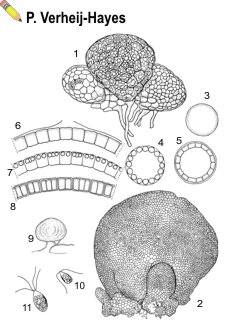Record Number
731
PROSEA Handbook Number
15(1): Cryptogams: Algae
Taxon
Dictyosphaeria cavernosa (Forssk.) Børgesen
Protologue
Revis. Forssk. alg.: 2, pl. 1, fig. 1 (1932).
Family
SIPHONOCLADACEAE
Chromosome Numbers
2n = unknown
Synonyms
Ulva cavernosa Forssk. (1775), Valonia favulosa C. Agardh (1822), Dictyosphaeria favulosa (C. Agardh) Decne. ex Endl. (1843).
Vernacular Names
Australia: Green bubble weed (En).
Origin and Geographic Distribution
Dictyosphaeria cavernosa is widely spread in tropical and subtropical seas all over the world. In South-East Asia this alga is recorded in all countries except Cambodia, Vietnam and Brunei Darussalam.
Uses
Dictyosphaeria cavernosa is used as human food and as an antimicrobial medicine. No toxic effects to eukaryotes are known.
Description
Thalli sessile, dark green, hollow, 2—5(—12) cm in diameter, nearly spherical, irregularly lobed or partly collapsed, occasionally concrescent; sometimes rupturing, irregularly saucer-shaped, and in deep water reaching a diameter of 30 cm, attached by irregularly elongated (rhizoidal) cells; thallus surface consisting of a single layer of large angular vegetative cells, 0.1—1(—4.5) mm in diameter; connecting tenacular cells numerous, 35-50 µm x 60—65 µm, lenticular, with simple or bifurcate haptera, often with fimbriate distal margins. Life cycle diplo-haplontic and isomorphic. Sporophytes with quadriflagellate zoospores; male and female gametophytes producing biflagellate isogametes.
Image
 | Dictyosphaeria cavernosa (Forssk.) Børgesen – 1, habit of a young specimen; 2, habit of a mature specimen; 3, cross-section of an undivided unicellular primary vesicle [diagrammatic]; 4,5, formation of secondary vesicles inside the primary vesicle [cross-sections, diagrammatic]; 6, the original wall of the primary vesicle has burst; 7, spherical protoplasmatic bodies are formed; 8, tertiairy vesicles have been formed [6,7,8 diagrammatic cross-sections to show formation of tertiairy vesicles]; 9, habit of unicellular germling; 10, gamete with 2 flagella and an eyespot; 11, zoospore with 4 flagella and an eyespot |
Growth and Development
Isogametes of Dictyosphaeria cavernosa can also develop parthenogenetically and then form new gametophytic thalli. When young, thalli form hollow spheres which rupture when mature. Isogametes fuse soon after release and the resulting zygotes settle on the substrate, germinating without any delay. Quadriflagellate zoospores, zygotes, and even unfused parthenogametes germinate in a fundamentally identical way after shedding their flagella. They first round up, forming a cell wall within 24 hours, then increase their volume and develop into spherical bodies, which produce some rhizoidal filaments. About three months after germination, segregative cell divisions take place within the unicellular germlings, which are by then 3—5 mm in diameter. First many spherical protoplasmic bodies are formed, which then develop into a layer of polygonal daughter cells that together form the monostromatic mature thalli. These are attached by rhizoidal cells formed by elongation of basal cells.
Ecology
Dictyosphaeria cavernosa is commonly found on rocks and reefs in the intertidal zone, where it is however often poorly developed. A little lower down on the shore it reaches full size, and it has also been recorded at depths of up to 55 m. The composition and texture of the rocky substrate greatly influence communities of this alga. It often grows on white, porous shell remains, which reflect light and have a high waterholding capacity. The alga can penetrate this substrate and then grow in semiprotected niches.
Propagation and planting
Phycoculture of Dictyosphaeria cavernosa is not known.
Harvesting
Dictyosphaeria cavernosa is harvested only by hand-collecting.
Handling After Harvest
Dictyosphaeria cavernosa is mainly used fresh.
Prospects
The use of Dictyosphaeria cavernosa as human food is likely to remain limited. Its antimicrobial capacity might be developed in the future.
Literature
Enomoto, S., Hori, T. & Okuda, K., 1982. Culture studies of Dictyosphaeria (Chlorophyceae, Siphonocladales) II. Morphological analysis of segregative cell division in Dictyosphaeria cavernosa. Japanese Journal of Phycology (Sôrui) 30: 103—112.
Enomoto, S. & Okuda, K., 1981. Culture studies of Dictyosphaeria (Chlorophyceae, Siphonocladales) I. Life history and morphogenesis of Dictyosphaeria cavernosa. Japanese Journal of Phycology (Sôrui) 29: 225—236.
Enomoto, S. & Okuda, K., 1981. Culture studies of Dictyosphaeria (Chlorophyceae, Siphonocladales) I. Life history and morphogenesis of Dictyosphaeria cavernosa. Japanese Journal of Phycology (Sôrui) 29: 225—236.
Author(s)
P.Y. van Aalderen-Zen
Correct Citation of this Article
van Aalderen-Zen, P.Y., 2001. Dictyosphaeria cavernosa (Forssk.) Børgesen. In: Prud'homme van Reine, W.F. and Trono Jr, G.C. (Editors): Plant Resources of South-East Asia No 15(1): Cryptogams: Algae. PROSEA Foundation, Bogor, Indonesia. Database record: prota4u.org/prosea

All texts are licensed under a Creative Commons Attribution-Noncommercial-Share Alike 3.0 Netherlands License
This license does not include the illustrations (Maps,drawings,pictures); these remain all under copyright.